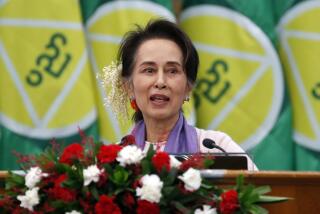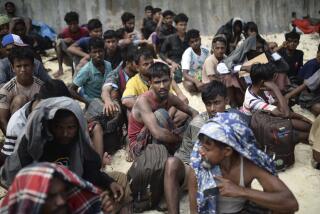Myanmar travel: Seeing Bagan, more before Westernization ruins it
BAGAN, Myanmar — Mr. Aye has a round, aged face and a wide, betel-nut-stained smile. Like many Burmese, he punctuates his speech with giggling, which can be alarming to a Westerner.
“Just three years ago, hehehe,” he says, “if I’d been seen reading one of Aung San Suu Kyi’s books, I would have been taken somewhere by the military, and my family would not know where. I read them all in secret. Not even my family knew. Hehehe.”
That scenario seems unfunny to me, but when you have lived most of your life under a military dictatorship, you perhaps find delight in having escaped an unjust fate at the hands of an oppressive government and living to see it toppled.
Times are changing in Myanmar, and it’s happening with 21st century speed. The military junta, bowing to crippling international sanctions and pressure, was dissolved in 2011 (although military cronies still retain power over most government positions). Just the fact that Mr. Aye, a Burmese historian and guide, was able to speak without fear more than suggests progress.
Aung San Suu Kyi, the Nobel Peace Prize winner and chairwoman of the oppressed National League for Democracy, was released from house arrest in 2010, and ever since tourists have rushed into the country. This onslaught of visitors (820,000 in 2011; 1 million in 2012 and 1.5 million estimated in 2013) means there are insufficient hotel rooms and that travelers must book months, sometimes even a year, in advance.
It also means feverish hotel construction, and not always with the best planning. If this part of the world is on your bucket list, book now through a tour company or an alumni organization. And unless you are an experienced independent traveler, I would recommend having a guide in each town because few people speak English and this is not an easy country to navigate solo.
Mountain Travel Sobek, a California-based adventure travel company, arranged my trip. The plans took six months to come together, and even then I didn’t always get preferred flights and hotels. In the end, it didn’t really matter.
Myanmar, formerly known as Burma, had always been on my personal list, but I made the decision to boycott the country while Aung San was in custody and the government’s human rights record was so deplorable. Still, I wanted to see the fabled land written about by Marco Polo and George Orwell, although I knew I might find devastation and neglect in a country suppressed for more than 50 years.
But what I found was a place of enormous beauty and kindness, although not without its frustrations.
I chose to avoid Mandalay and Yangon, the two largest cities, because they are noisy, crowded and congested. Instead, I stuck to the rural areas of Bagan, a legendary town of gilded pagodas; Inle Lake, a traditional water-based community; and Kalaw, a former British colonial hill station known for rustic hiking and hill tribes.
Mr. Aye was my guide in Bagan, and his oddly timed tittering didn’t distract from his passion for, and knowledge of, Myanmar.
“Bagan,” he told me, “is filled with pagodas because each wealthy family had to outdo the other in their devotion. At one time there were over 10,000 Buddhist temples and pagodas here. Now we will climb to see the sunset from one.”
The view below was a vast, hazy plain of green fields studded with spires of rounded pagodas, large temples and monasteries. Some gleamed gold in the sunlight, and some had the original reddish façade that dated as far back as the 11th century.
Visiting Bagan, a farming community on the banks of the shimmering Ayeyarwady River (also spelled Irrawaddy), is a must. (I did my best to avoid the tour buses and guidebook stops at peak hours.) My favorite way to escape was to hire a horse-drawn buggy, the traditional taxi in Bagan, and tour the back roads, villages and less celebrated pagodas at sunset.
I would stop along the way to wander into the fields and meet the locals, who spoke only Burmese but seemed delighted to greet me nevertheless. In seemingly every field there were spectacular 11th century spires. Beneath them, dressed in their lungis (traditional skirts worn by men and women) and conical hats, farmers harvested squash and beans, accustomed to the glory of their surroundings.
I would arise early to beat the heat and the crowds at the popular temples in Old Bagan, such as the Ananda Pahto and the lovely Shwesandaw Paya. Later, rather than stopping at tourist stores, I’d ask to go to a workshop where I could see local crafts being created and buy directly from the makers.
Lacquerware is Bagan’s specialty, and the work is so heartbreakingly painstaking that it is difficult to appreciate the 15 layers of lacquer and intricate decoration without having witnessed it.
At sunset I’d head out, either climbing a pagoda or taking to the back roads via buggy, mesmerized as the dropping sun ignited the golden domes and spires. I knew Marco Polo had a similar awe-struck reaction when he visited this mystical land at the height of its power.
From Bagan, I took a chaotically delayed flight to Heho, in the center of the country, and was driven an hour and a half east to Kalaw, a town in the pine-covered hills. Kalaw, established by British colonialists in the early 1900s as a retreat from the lowland heat, is slightly shabby, and the only reason to visit is to trek and visit with what is left of Burma’s hill tribes.
The surrounding valleys are beautiful, bucolic and untouched, with villages clinging to hillsides and mountains as far as the eye can see. Mr. Moe, my new guide, and I hiked up one such valley to reach the Pein Ne Pin village inhabited by the Gold Palaung tribe.
I spent a happy afternoon with Palaung women in their bamboo house while they served roasted homegrown tea. I sat on the floor of the monastery and drank more tea with a lone monk, then watched Buddhist nuns cook over an open flame.
Hiking down, we encountered a set of tranquil white stupas beside the trail, the bells on the silver crowns tinkling in the breeze. Perhaps this was the original purpose of these Buddhist shrines, to walk around them in peace and with presence.
From Kalaw it’s a three-hour drive to Inle Lake, lodged between two mountain ranges. Once at the lowland lakeside township, Mr. Moe and I took a longboat with my luggage and headed out on the vast lake to Villa Inle, a lovely hotel built on the water’s edge with five-star, free-standing bungalow rooms that overlook floating gardens of fiery water lilies.
There’s only one way to get about at Inle and that is by an open-air, narrow longboat with chairs — and noisy diesel motors. Inle is where I most felt the crush that tourist demand is creating. Hillsides have been bulldozed to make way for hotels and luxury housing, and touts have begun to hound foreigners with, “Buy this today cheap special price.” Of all the places, Inle is the one to visit before Westernization ruins it.
Right now, though, it is spectacularly lovely. The fishermen still wear baggy pants and row with their legs as they toss nets. Villagers still sell vegetables from wooden boats, gliding between the over-the-water stilt houses. Women still sit all day weaving sumptuously patterned fabrics from silk and cobweb-like fibers ripped from the stems of lotus flowers. Men still hunch over pure silver, hammering out patterns to create jewelry and temple offering bowls.
At one end of the lake are the not-to-be-missed Indein ruins, the lower part of which is still in its original, untouched condition, with trees and roots fusing, Angkor Wat-style, with ornately carved pagodas. Above, however, the authorities have begun to “remodel” the pagodas, meaning they are covering them with fresh cement and a coat of gold paint. Archaeologically compromised? Most certainly. Another reason to get here before more of the country’s gracious history is “remodeled.”
“When you go back to your country,” Mr. Aye had told me as I left Bagan, “tell people that we are here waiting and hoping for the best. Burmese always hope for the best. And sometimes the best happens.”
More to Read
Sign up for The Wild
We’ll help you find the best places to hike, bike and run, as well as the perfect silent spots for meditation and yoga.
You may occasionally receive promotional content from the Los Angeles Times.






